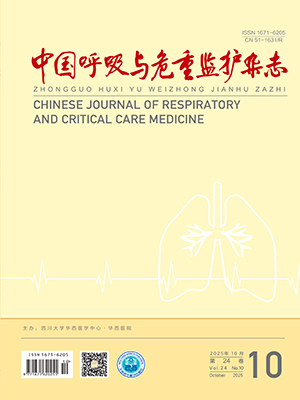Objective To explore the correlation between the levels of nitrite / nitrate( NO2 /NO3) in exhaled breath condensate ( EBC) and pulmonary infection in mechanically ventilated patients. Methods The clinical data from ventilated patients in critical care units of Peking University People’s Hospital from November 2006 to August 2007 were collected and analyzed. The patients’clinical pulmonary index score ( CPIS) were calculated. EBC of those patients were collected via endotracheal tube or tracheostomy cannula,and the concentrations of NO2 /NO3 were assayed. The level of NO2 /NO3 in different CPIS patients in 24 hours’ventilation, weaning proportion in 3 days and mortality in different NO2 /NO3 level patients were compared. The correlation of the CPIS and level of NO2 /NO3 were explored between survival and non-survival patients. Results A total of 76 patients were enroled. The NO2 /NO3 levels in patients of CPIS≤3, CPIS 3-6 and CPIS gt;6 in 24 hours of ventilation were ( 23. 31 ±5. 79) , ( 28. 72 ±9. 10) and ( 35. 42 ±12. 10) μmol / L respectively, with significantly differences between each other ( P lt; 0. 01) . The lower the patients’concentration of NO2 /NO3 was, the earlier the weaning and the lower the mortality were. The NO2 /NO3 levels on 4th and 7th day were detected in 24 survival patients and 23 non-survival patients. The difference of NO2 /NO3 levels between the survival patients and non-survival patients became significant on 7th day [ ( 29. 32 ±9. 52) μmol / L vs. ( 37. 22 ±12. 03) μmol / L, P lt; 0. 01] . Linear correlation analysis showed that the NO2 /NO3 level was positively correlated with CPIS ( r = 0. 76, P lt; 0. 01) . Conclusions The NO2 /NO3 level of EBC in ventilated patients is positively correlated to the severity of pulmonary infection, thus may be used as a new predictor for weaning and prognosis.
Citation: XUE Xiaoyan,GAO Zhancheng. Correlation Between the Levels of NO2 /NO3 in Exhaled Breath Condensate and Pulmonary Infection in Mechanically Ventilated Patients. Chinese Journal of Respiratory and Critical Care Medicine, 2009, 09(4): 333-336. doi: Copy
Copyright © the editorial department of Chinese Journal of Respiratory and Critical Care Medicine of West China Medical Publisher. All rights reserved




